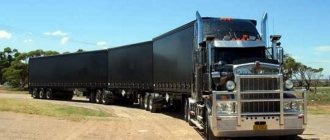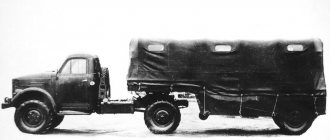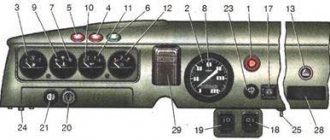Vladimir Chekhuta, photo by Kögel company
Renowned car manufacturer IVECO has taken the lead in promoting the new longer (18-metre) vehicles, with demonstration runs taking place in mid-October at a test site near Millbrook in Bedfordshire, England. The event was organized by the British Road Transport Association with the invitation of specialists from the local Ministry of Transport, government officials, trade associations, members of parliament and media representatives.
The purpose of the demonstration performances of the elongated road train was the desire of supporters of the pan-European idea to convince Her Majesty's responsible officials to undertake an experiment and allow the trial operation of 18-meter road trains on public roads.
Eighteen meters
So why 18 meters? And what is this new PAN-EUROPEAN initiative? Let me remind you that today in Europe vehicles with a maximum overall length of 16.5 m (in the CIS - 20 m) and a gross weight of 40 tons are considered legal. Of course, all entrepreneurs, including transport workers, want to have a stable and good income, but how to support it, you ask? The economic crisis hit freight hard - many even had to leave their usual business. For example, due to a significant decrease in the volume of transported cargo that occurred in Germany from October 2008 to October 2009, transport companies fired about 30 thousand drivers. Some companies simply laid up their cars. Thus, according to the German federal transport agency KBA, from January 1 to September 1, 2009, the registration of 60 thousand trucks with a gross weight of more than 12 tons was canceled, i.e., about 17% of heavy vehicles previously owned by German road carriers stopped working . In addition, the introduction of a new environmental standard for engines on October 1 encourages companies to change rolling stock, but obtaining and paying for a loan has become difficult. It is clear that the bleak picture is everywhere, and all road transport workers need some positive ideas.
In this regard, associations of road transporters in several European countries remembered the Big-MAXX trailer from Kögel Fahrzeugwerke GmbH and realized that a small change in the length of the semi-trailer would not lead to any fundamental correction in the road sector, and the addition of several useful “cubes” would certainly add enthusiasm to transport companies . Therefore, they took up this idea and began to actively push through the European Commission a new standard for a longer and more profitable vehicle.
More than a hundred “cubes”: extended semi-trailers
The volume of cargo transportation by road in Russia is growing. However, the capacity of the road network, despite its intensive development, is still insufficient. The use of extended semi-trailers permitted by our rules can help to radically increase the intensity of transportation.
Mikhail Nevzgodin
The design of the frame and chassis of an extended semi-trailer is practically no different from standard models
The current Rules for the transportation of goods by road allow the operation in Russia of road trains up to 20 m long. Interestingly, this limit was approved relatively recently - in 2011, and previously they were guided by the technical regulations “On the safety of wheeled vehicles”, in which the longitudinal dimensions of the road train for a combination the tractor-semi-trailer was limited to the 16.5-meter mark. The old restriction, which was even stricter than the European one, did not suit many, including owners of American bonnet trucks, which, even in combination with standard semi-trailers, sometimes did not fit within the limits of the restrictions. And now the rules have changed.
Especially for Russia: Krone Profi Liner model SD - extended
Of course, not only the owners of American equipment benefited from the innovation. It has become easier for other carriers as well. The main advantage of increasing the longitudinal dimensions of vehicles is the large coupling capacity, which not only leads to a reduction in transport costs (fuel and driver wages), but also improves the environment. As confirmation, mention should be made of the development of the European EuroCombi project - road trains with a length of 25.25 m, pursuing similar goals. On the other hand, transport analysts claim that in Russia heavy and super-heavy transport is only 60–70% loaded in terms of utilization. From this point of view, the need for extended coupling on the road looks less convincing if the transport is not supported by logistics management and supervision. In general, there are nuances. Nevertheless, the market for extended trailers in Russia has been growing recently, both in volume and in the range offered.
THREE METERS IN THE “TAIL”
Standard curtainsider semi-trailers have a length of 13.6–13.7 m, the internal volume of the cargo space is about 90 m3, which can accommodate 33–34 Euro pallets. The longitudinal dimension of a long semi-trailer, depending on which tractor is to be worked with, can be 16.5 or 17 m, and in some cases - 17.2 m. When traveling along highways, an extra 3 meters in the “tail” They are not felt, but they add inconvenience when maneuvering in narrow passages. This problem can be solved by installing a lifting or rotating axle.
Increasing the capacity of a road train means reducing transport costs
The frame design of an extended trailer is practically no different from standard models. Depending on the customer’s preferences, the frame can be straight or “broken” - Jumbo type with upper and lower loading areas. Depending on the length of the semi-trailer and the type of frame, the internal volume of the cargo space will be about 120–122 m3, accommodating up to 42 Euro pallets.
Moreover, not only “awning” trailers can be manufactured according to this scheme - both curtain and side trailers are in great demand, because in everything else, except for the curb weight slightly increased due to excess metal, an extended semi-trailer is not much different from a regular one - the same reinforced steel frame , 3-axle chassis and a wide range of configurations and additional options, allowing you to adapt the vehicle to any transport task.
BRANDS AND MODELS
The lion's share of the extended semi-trailer market belongs to Russian manufacturers, which, however, is not surprising - the product turns out to be niche. manufactures a whole family of extended tilt, curtain and flatbed trailers for long-distance transportation. The most spacious is the 17-meter curtain “Yumba” with an internal volume of 122 m3. The manufacturer assumes the installation of sides of the height required by the customer, ferry hinges, and a roof lifting mechanism. The interior of the body can be lined with plywood and equipped with niches for transporting rolled cargo.
A representative of the “Meusburger Novtrak” family of extended curtain-type semi-trailers is the 17-meter curtain-sided “Yumba” with an internal volume of 122 m3
offers a curtain-sided curtain-sided trailer with the industry designation 946832. With an overall length of 17 m, the internal volume of the cargo compartment is 111 m3, and the load capacity is 28 tons. Especially for operation in harsh road conditions, the semi-trailer received a steel frame of increased strength with double-sided welding of the belts.
The 4-axle Tonar 97463-000010, 16.5 m long, holds 102 m3, it can transport up to 40 tons of cargo without violating the rules
The Velikiy Luki Experimental Machine-Building Plant (Steelbear brand) launched a 16.5-meter PT-24K tilt trailer, adapted for operation with a 2-axle tractor with air suspension. , perhaps, delved deeper into the topic than anyone else. Engineers from Gubino near Moscow offered the market a new model of a 4-axle tilt (with a U-shaped sliding awning) semi-trailer Tonar-97463-000010. The new product, 16.5 m long, holds 102 m3, and the load capacity reaches 40 tons. The first and second axles are lifting as standard. The use of the fourth axis is not accidental. The fact is that in the new edition of the Rules for the Transportation of Goods by Road, the permissible total weight of a 6-axle road train has been increased to 44 tons (previously it was 40 tons). The only thing left for carriers to do is take advantage of this concession wisely.
In conclusion, good news from foreign manufacturers. The Krone company has begun sales in Russia of a new model of tilt semi-trailers Krone Profi Liner - SD with a length of up to 16.5 m and a volume of up to 110 m3 with a standard tractor seat height of 1150 mm.
The maximum length of a semi-trailer train in Europe is 16.5 m, in Russia - 20 m
The editors recommend:
Why do piston rings stick and how to prevent it?
A traffic police officer searched my car: did he have the right to do so?
Russians may be left without foreign cars: Western automakers have stopped supplying cars to our country
A ship that was transporting cars to Russia was detained in France
Half of the car factories in Russia have closed
News Media2
Discussion Cancel
A little bit longer
Back in 2005, Kögel developed its Big-MAXX custom-length concept semi-trailer, which offered a 12% increase in load capacity compared to the existing standard combination. The new product was first shown at the Hanover International Exhibition IAA in September 2006. Of course, no specially adapted tractor unit is needed to tow it. The “Bolshoi-MAXX” in curtain version with a length of 14.92 m can load 37 Euro pallets instead of 33, like the 13.6-meter truck of the existing standard. Of course, increasing the length of the semi-trailer by 1.32 m would give the carrier a significant reduction in fuel consumption and increase profitability, and environmentalists would be happy with the fact that there was a reduction in CO2 emissions per pallet delivery. In addition, the “legalization” of an 18-meter road train would allow European transport workers to undertake the delivery of ISO-standardized 48-foot sea containers by road without obtaining an additional permit. But most importantly, governments would not be required to invest additionally in road infrastructure and improve safety.
International efforts and trials
As already mentioned, a fairly powerful lobby has formed in the UK, which is trying to “take the length” of 18 m. It calls on the Department of Transport (analogous to our Ministry of Transport) to immediately allow testing of longer semi-trailers on the country’s roads. Henk Van Leeveen, managing director of IVECO UK, believes that “moving towards 18 meters would improve the economics of the transport business, reduce the environmental impact of cars and reduce the number of vehicles on the roads. And the extra length of the trailer would be barely noticeable to the untrained eye.” The fact that in Britain there is a powerful association of road carriers, which has learned to push the government for the legislative changes necessary for its wards, can be confirmed by example. Thus, in 2001, a new road standard was introduced in the United Kingdom, allowing the use of a vehicle with a maximum gross weight of 44 tons. While in continental Europe they are wondering whether it is worth abandoning the usual 40 tons, in the meantime, transport workers in Britain are making money on this delta .
In September 2009, again at the initiative of IVECO, the “Diciotto” (“Eighteen”) project was launched in Italy. ANFIA (Italian Association of Automobile Manufacturers and Automotive Traders), with six of the country's largest transport companies, approached the government, and it authorized a local study of 15 extended road trains. Orders for 15-meter semi-trailers were divided between Italian automakers: Merker, Viberti, Rolfo and Omar. In May 2010, the Berlusconi government will review the reports and, most likely, agree on full-scale tests in the Apennines. They are due to be completed in May 2012, after which the Italian government will decide whether to make changes to road standards or not.
In Germany, 50 operators have been conducting research with three hundred 18-meter vehicles for four years now. In two years, Berlin plans to announce their results.
In June 2009, the Polish government issued special permanent permits for 300 semi-trailers with an extended length of 14.92 m. These 18-metre road trains will be used throughout the national transport system. For this experiment, 150 trailers will be manufactured by Kögel, and the rest of the extended semi-trailers will be made by the Polish company Wielton. The Transport Institute in Warsaw (Instytut Transportu Samochodowego) was entrusted with monitoring and analyzing the results of the experiment on the use of 18-meter road trains. It sounds like a nice “part of a national experiment to evaluate the advantages and disadvantages of operating longer vehicles,” but the Polish government did not make “gifts” to road carriers. If you want to carry more, you have to pay more. A special pass, valid for a year, for one extended trailer costs 800 euros.
The Czech leadership has the same mercantile approach. Any Czech transport company can use Big-MAXX without restrictions regarding travel routes. The number of passes is not limited, you just need to pay for them. The permit is issued for a period of three months and costs 220 euros for this period. In other words, the Czechs, without any pompous phrases, “legalized” long vehicles for the money of motor carriers. That is, the government is completely clear and does not need any research, it just needs money. But for what?
The Netherlands, Spain and other European countries have expressed significant interest in the Kögel “Big-MAXX” (+1.32 m) concept.
The longest off-road road train
The longest off-road road train, LeTourneau TC-497, was built in the early 1950s in the USA.
The idea of creating off-road road trains appeared among the American military at the turn of 1940-50. They believed that the American army needed a vehicle that would allow it to transport large quantities of cargo off-road while destroying railroads and highways during the war.
The order to develop an off-road road train was received by engineers from the American company LeTourneau. They designed and created a train on wheels that did not require special conditions to transport cargo.
The length of the LeTourneau TC-497 was 173 meters, the cabin height was 9 meters, and the load capacity was more than 400 tons. The giant had 54 wheels, each with a diameter of 3.5 meters. Firestone made especially durable tires.
Each wheel was equipped with an individual electric motor; the drive unit for the generating set was a gas turbine engine. The total power of the four gas turbine engines was 5000 hp.
The road train had 8-12 trailers on which equipment and cargo with a total weight of up to 150 tons were transported, while the total weight of the road train itself was about 450 tons.
In addition to cargo trailers, the road train also had trailers to accommodate a crew of six with space for sleeping, eating, sewage, and even an automatic laundry.
Due to the gigantic size of the road train, certain difficulties arose in control, so the developers of LeTourneau TC-497 installed an electronic control system on the vehicle.
The driver transmitted commands from the tractor control panel to actuators on all links, due to which each link began performing the maneuver at the same point at which the lead tractor did it. The result was maneuverability, which allowed the road train to avoid various obstacles.
Testing of the LeTourneau TC-497 road train began in 1962 at the Yuma Proving Ground in the Arizona desert and continued until approximately 1969. According to the test results, the maximum speed achieved was 35 km/h, and the range was 600 km. The giant road train successfully avoided obstacles and was able to move through sandy terrain, rough terrain and snow.
However, after the tests were carried out, the project was closed. The reasons were the complexity of the machine and the high cost of the road train: the cost of the project was about $3.7 million. In addition, the US Army received heavy transport helicopters that could perform the same tasks, but much faster and cheaper.
The tractor is now kept in a museum, and the vans were cut up for scrap in 1971.
Key Benefits
Among the main advantages is an increase in transportation efficiency and a reduction in the number of trucks on the roads. In addition to the four Euro pallets, 18-metre road trains would significantly improve the compatibility of intermodal transport by rail, sea and road. This would increase the speed of transport flows, because back in 2007 the EU issued a forecast that the amount of goods moved in 2022 would double compared to 1990.
Currently, trucks operating in Europe can transport 20- or 40-foot shipping containers, with the larger 45-foot container only subject to special permission. But the International Organization for Standardization (ISO) has certified 48-foot containers, which are already used in rail and sea transport. Legalizing the full 18-metre vehicle length would allow road hauliers to deliver 45- and 48-foot containers by road without additional permits or inefficient overloading.
IVECO UK director Martin Flack explains: “By coordinating cross-modality between road, rail and maritime transport corridors, we will make our freight flow more efficient. This will lead to fewer trucks on our highways and lower carbon emissions.”
So, the benefits are obvious: this is additional profit for road carriers, acceleration of cargo turnover, reduction of traffic congestion and improvement of the environment. And most importantly, no additional investments in existing road infrastructure will be required from EU governments. And one more thing is additional orders for the auto industry. The legalization of 15-meter trailers will definitely affect the change in demand. Old semi-trailers will begin to go en masse to the secondary market, and trailer manufacturers will “take a deep breath.” In addition, the Big Seven will probably come up with some specially adapted versions of truck tractors for optimal towing of extended semi-trailers. Of course, the consumer wins, but the manufacturer is not offended either.
How to choose a semi-trailer for a tractor
21.02.2017
Let's consider the question of how to choose a semi-trailer for a tractor. One of the main parameters when selecting is the height of the fifth wheel coupling from the road level. The following SSU heights are more common:
— 1.15 m for tractors with a 4x2 and 6x2 wheel arrangement and for flatbed semi-trailers, curtain-sided trailers, container ships and refrigerators;
- 1.25 - 1.35 m for tractors with a 6x4 formula and for dump semi-trailers, heavy trucks and tanks.
It must be taken into account that when selecting a semi-trailer for a tractor, the difference in the height of the fifth wheel coupling device is allowed to be no more than 5 cm. Thus, for a semi-trailer with a toe height of 1.2 m, a tractor with a toe height in the range from 1.15 to 1.25 m will be required If necessary, the height of the tractor control system can be adjusted by installing special adjustment plates.
When selecting a semi-trailer for a tractor, it is also necessary to take into account the number of wheels on the axle on one side. If the tractor has single wheels, then the semi-trailer should have the same ones. This is certainly not a critical wish.
For those who are interested in how to choose a semi-trailer for a tractor, you should pay attention to the brake mechanisms of both the tractor and the semi-trailer. Ideally, this would be to choose the same type of brakes, which will allow the braking systems of the road train to work more consistently and to use braking more effectively when necessary. This directly affects transportation safety.
Among other things, when choosing a semi-trailer, you need to take into account what type of suspension is used on the tractor. For tractors with spring-balancer suspension, it is necessary to select a semi-trailer with spring-balancer suspension. For tractors equipped with spring suspension, a semi-trailer with spring suspension is suitable. For two-axle tractors, a three-axle semi-trailer is required due to the weight distribution along the axles. If the tractor has an air suspension, then the semi-trailer should also be selected with an air suspension.
When deciding how to choose a semi-trailer for a tractor, you need to remember about possible problems when the length of the road train exceeds the permitted ones. This is especially important for tractors with a hood. If you need to transport a long semi-trailer, you will have to use a “short” hoodless truck tractor. In addition to dimensions, it is necessary to remember the standards for axle loads and the total weight of the road train. It is necessary in advance, knowing the weight of the cargo, to take into account which tractor and semi-trailer will be needed to deliver this cargo in order to avoid penalties for exceeding these parameters.
The above recommendations for selecting equipment will allow you to avoid problems during operation. If you have any questions, you can contact our auto experts. provides a wide range of services related to motor transport equipment, including the acquisition of necessary equipment. Our specialists will quickly help you select the necessary equipment at an affordable price.
To other reviews
logisline.ru
Safety
As demonstrated by IVECO's demonstration runs with the Big-MAXX trailer at Millbrook, the 18-metre vehicles can operate effectively within EU agility requirements. They will not create an unfavorable traffic situation that affects traffic safety. This means that extended road trains can operate safely within existing road infrastructure, which includes highways, bridges, overpasses, tunnels, parking lots, gas stations, streets and city intersections. These objects will not require any correction. Eighteen-meter automatic couplers do not require special driving methods, and all existing road safety systems Advanced Driver Assistance Systems (ADAS) will be successfully applied to them.
According to experts from the German automobile association Allgemeinen Deutschen Automobilclubs (ADAC), additional safety measures will not be needed when using extended road trains.
Martin Flack explains in this regard: “By highlighting the practicality of longer vehicles, the following can be noted. Most road users won't even notice that the trailers are 1.5m longer, as the 18m vehicles will look similar to the regular road trains they now see on the roads. In addition, the dimensions of the new product will not exceed the length of the automatic coupler permitted today (three-axle tractor-trailer + trailer), which throughout the EU has a maximum length of 18.75 m.”
Returning to the Millbrook event, IVECO UK driver Paul Walker successfully completed a variety of maneuvers that simulated the movements that trucks are forced to make every day. This is a drive into a marked bay (simulating the delivery of a truck for loading or a parking space), demonstrating that a longer vehicle will not interfere with other cars overtaking it on the freeway. Commenting on his first experience, driver Volker O.
Neoplan N138 Der Bus
0
Source:
Der Bus began its life as a completely ordinary Jumbocruiser, until in 1995 it fell into the hands of Manfred Esterbauer. Manfred not only restored the middle-aged bus, which was produced in 1975, but also turned it into a mobile home. The largest mobile home that is allowed on public roads. And to be more precise, 18 meters in length and 4 meters in height are proof of this.
0
Source:
Inside Der Bus there is a spacious salon with several rooms, a toilet with shower and a full kitchen. There was even room for a small garage in which you can park an ATV. A separate electrical installation is responsible for the life support of the systems, and a Webasto autonomous heater and DeLonghi air conditioner are responsible for the comfort of passengers. The record-breaking bus is currently on sale.
CIS prospects
Kögel says that its 15-meter (rounded 14.92 m) trailers could receive vehicle certificates in Belarus, Ukraine and Russia without any modifications or changes at all, since they fit into the road standards of these countries. In this regard, I have the following question. If domestic automakers sell 99% of their semi-trailers and almost the same amount of truck tractors to CIS consumers, then why do they make road trains so short, as if they will be used to buy goods in Europe? After all, we have legalized a 20-meter vehicle length, but they produce strictly 16.5 m!
Who will finally “find” the missing 3.5 m of usable space and offer it to the carrier?
And when pompous associations of international road carriers, supposedly absorbed in the concerns of transport workers, go to their governments and explain to them that the maximum permissible gross weight of a five-axle or six-axle road train is 38 tons - this is ridiculous and simply stupid!
In conclusion, I would like to express the opinion that the data obtained as a result of testing 15-meter trailers in different European countries will not go unnoticed by road carriers. Surely transport associations will bring them to European Union officials and persistently propose changing the length of EU road vehicles.
Today, Kögel offers four different versions of the 14.9 m long "Big-MAXX" trailer. This is the Big-MAXX Mega curtain-sided semi-trailer, designed to increase the volume of transported cargo. The space of this truck reaches a volume of 111 m3; the refrigerated version of Big-MAXX Coo is designed for transporting perishable goods; Big-MAXX rail is specially adapted for transportation by various modes of transport, including rail and sea; the latest version of Big-MAXX is a platform designed for transporting oversized 15-meter cargo (such as pipes) and various sea containers.
Australian giants
The livelihood of Australia's cattle ranches depends on a vehicle that can pull 100 tonnes of weight. The distances between settlements are hundreds of kilometers.
To deliver goods, road trains are used, providing farms with everything they need, from the delivery of live goods (sheep, cows) to the export of finished products.
Automotive giants are comfortably equipped because their journeys are usually very long.
The main responsibilities of the driver:
- don't fall asleep while driving;
- Be careful;
- rest and eat well.
conditions have been created in the car cabin :
- air conditioner;
- small refrigerator;
- sleeping area.
Among these monsters of the roads there are supergiants that pull thousands of tons of cargo behind them in 10 or more trailers. You can see them here:
Mack Titan
The main owners of Australian roads are road trains from the American manufacturer Mack Titan . The model is intended for transportation of oversized cargo, as well as use in the oil and gas processing industry.
There is no demand in the European market. However, since 1995 it has been successfully used on Australian roads. “Titan” took root and became the main link between the regions.
In Queensland, Australia, in 2006, as an experiment, 112 trailers were attached to a Mack Titan tractor, the length of which was 1474.3 m. The weight of the structure was 1300 tons.
"McTitan" received the unofficial title of "the longest road train" . Naturally, we didn’t expect a long trip, but he managed 140 meters. It was a kind of presentation of the truck and its capabilities, which has successfully proven itself and is still in use today.
"American" Mack Titan
Kenworth C501T
Thanks to the smooth roads of Australia, multi-ton cargo is delivered to any corner of the country. The rulers of the deserts - heavy road trains - successfully cope with this.
One of these giants is the Kenworth C501T , the largest road train. It rushes along the highway at a speed of 100 km/h, pulling up to 500 tons of cargo.
As a presentation in 2000, a Kenworth C501T truck driver in Calgorie pulled a 1018-metre train of 79 trailers over 8 km. This spectacle attracted a considerable audience - 6 thousand spectators.
The longest road train on Australian roads
Kenworth K100G
Another leader among the longest road trains is the giant of the auto industry - Kenworth K100G .
Driver Greg Marley completed a record-breaking 8-kilometer drive with a tractor-trailer hauling 45 trailers in 1999. The length of the escort was 610 meters, the speed was 12 km/h.
Kenworth K100G tractor with semi-trailer











